Bacteria are prokaryotic, unicellular microorganisms, which lack chlorophyll pigments. The cell structure is simpler than that of other organisms as there is no nucleus or membrane-bound organelles.
Due to the presence of a rigid cell wall, bacteria maintain a definite shape, though they vary in shape, size, and structure.
When viewed under a light microscope, most bacteria appear in variations of three major shapes: the rod (bacillus), the sphere (coccus), and the spiral type (vibrio). In fact, the structure of bacteria has two aspects, arrangement, and shape. So far as the arrangement is concerned, it may Paired (Diplo), Grape-like clusters (staphylo), or Chains (strepto). In shape, they may principally be Rods (bacilli), Spheres (cocci), and Spirals (spirillum).
Size of Bacterial Cell
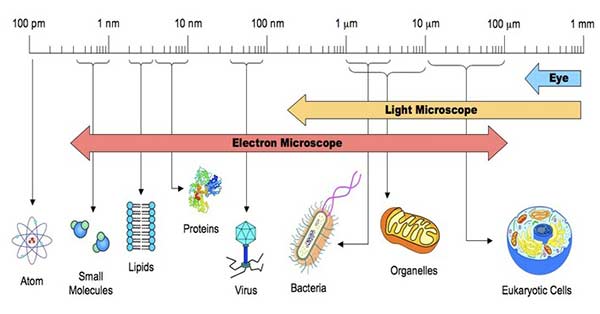
The average diameter of spherical bacteria is 0.5-2.0 µm. For rod-shaped or filamentous bacteria, the length is 1-10 µm and the diameter is 0.25-1 .0 µm.
E. coli, a bacillus of about average size is 1.1 to 1.5 µm wide by 2.0 to 6.0 µm long.
- Spirochaetes occasionally reach 500 µm in length and the cyanobacterium
- Oscillatoria is about 7 µm in diameter.
- The bacterium, Epulosiscium fishelsoni , can be seen with the naked eye (600 µm long by 80 µm in diameter).
- One group of bacteria called the Mycoplasmas, have individuals with size much smaller than these dimensions. They measure about 0.25 µ and are the smallest cells known so far. They were formerly known as pleuropneumonia-like organisms (PPLO).
- Mycoplasma gallicepticum, with a size of approximately 200 to 300 nm is thought to be the world's smallest bacteria.
- Thiomargarita namibiensis is the world’s largest bacteria, a gram-negative Proteobacterium found in the ocean sediments off the coast of Namibia. Usually, it is 0.1—0.3 mm (100—300 µm) across, but bigger cells have been observed up to 0.75 mm (750 µm).
Thus a few bacteria are much larger than the average eukaryotic cell (typical plant and animal cells are around 10 to 50 µm in diameter).
The shape of Bacterial Cell
The three basic bacterial shapes are coccus (spherical), bacillus (rod-shaped), and spiral (twisted), however, pleomorphic bacteria can assume several shapes.
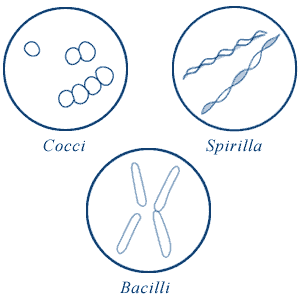
- Cocci (or coccus for a single cell) are round cells, sometimes slightly flattened when they are adjacent to one another.
- Bacilli (or bacillus for a single cell) are rod-shaped bacteria.
- Spirilla (or spirillum for a single cell) are curved bacteria which can range from a gently curved shape to a corkscrew-like spiral. Many spirilla are rigid and capable of movement. A special group of spirilla known as spirochetes is long, slender, and flexible.
Arrangement of Cocci
Cocci bacteria can exist singly, in pairs (as diplococci ), in groups of four (as tetrads ), in chains (as streptococci ), in clusters (as stapylococci ), or in cubes consisting of eight cells (as sarcinae). Cocci may be oval, elongated, or flattened on one side. Cocci may remain attached after cell division. These group characteristics are often used to help identify certain cocci.
1. Diplococci
The cocci are arranged in pairs.
Examples: Streptococcus pneumoniae, Moraxella catarrhalis, Neisseria gonorrhoeae, etc.
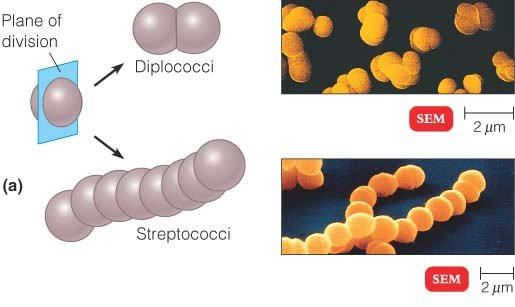
2. Streptococci
The cocci are arranged in chains, as the cells divide in one plane.
Examples: Streptococcus pyogenes, Streptococcus agalactiae
3. Tetrads
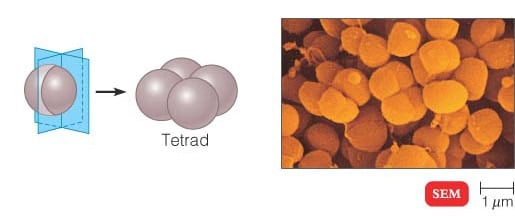
The cocci are arranged in packets of four cells, as the cells divide in two plains.
Examples: Aerococcus, Pediococcus, and Tetragenococcus
4. Sarcinae
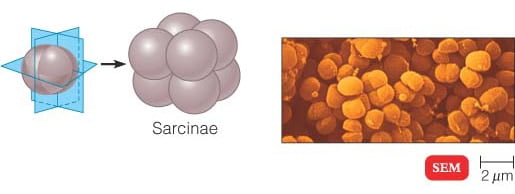
The cocci are arranged in a cuboidal manner, as the cells are formed by regular cell divisions in three planes. Cocci that divide into three planes and remain in groups cube-like groups of eight.
Examples: Sarcina ventriculi, Sarcina ureae, etc.
5. Staphylococci

The cocci are arranged in grape-like clusters formed by irregular cell divisions in three plains.
Examples: Staphylococcus aureus
Arrangement of Bacilli
The cylindrical or rod-shaped bacteria are called ‘bacillus’ (plural: bacilli).
1. Diplobacilli
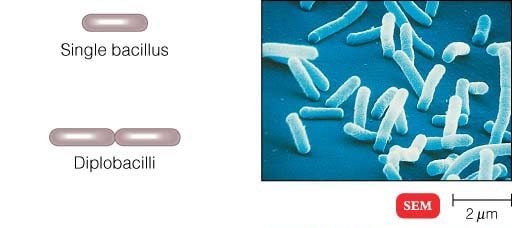
Most bacilli appear as single rods. Diplobacilli appears in pairs after division.
Example of Single Rod: Bacillus cereus
Examples of Diplobacilli: Coxiella burnetii, Moraxella bovis, Klebsiella rhinoscleromatis, etc.
2. Streptobacilli
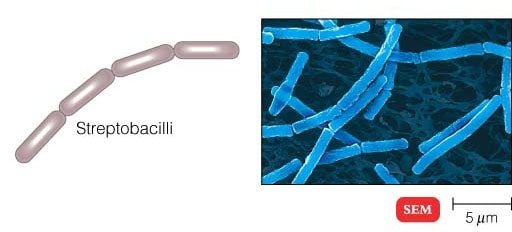
The bacilli are arranged in chains, as the cells divide in one plane.
Examples: Streptobacillus moniliformis
3. Coccobacilli
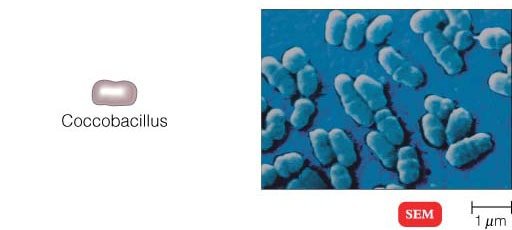
These are so short and stumpy that they appear ovoid. They look like coccus and bacillus.
Examples: Haemophilus influenzae, Gardnerella vaginalis, and Chlamydia trachomatis
4. Palisades

The bacilli bend at the points of the division following the cell divisions, resulting in a palisade arrangement resembling a picket fence and angular patterns that look like Chinese letters.
Example: Corynebacterium diphtheriae
Arrangement of Spiral Bacteria
Spirilla (or spirillum for a single cell) are curved bacteria which can range from a gently curved shape to a corkscrew-like spiral. Many spirilla are rigid and capable of movement. A special group of spirilla known as spirochetes are long, slender, and flexible.
1. Vibrio
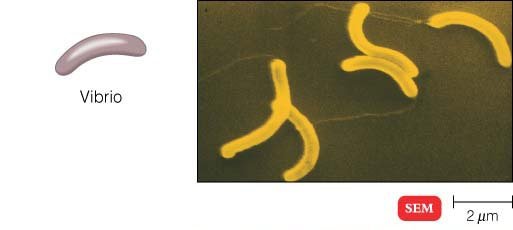
They are comma-shaped bacteria with less than one complete turn or twist in the cell.
Example: Vibrio cholerae
2. Spirilla
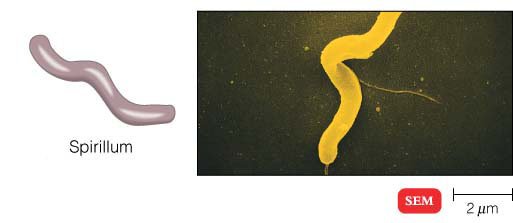
They have rigid spiral structure. Spirillum with many turns can superficially resemble spirochetes. They do not have outer sheath and endoflagella, but have typical bacterial flagella.
Example: Campylobacter jejuni, Helicobacter pylori, Spirillum winogradskyi, etc.
3. Spirochetes
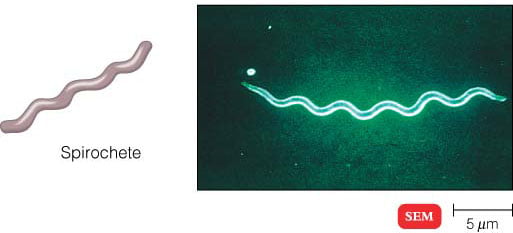
Spirochetes have a helical shape and flexible bodies. Spirochetes move by means of axial filaments, which look like flagella contained beneath a flexible external sheath but lack typical bacterial flagella.
Examples: Leptospira species (Leptospira interrogans), Treponema pallidum, Borrelia recurrentis, etc.
Others Shapes and Arrangements of Bacteria
1. Filamentous Bacteria
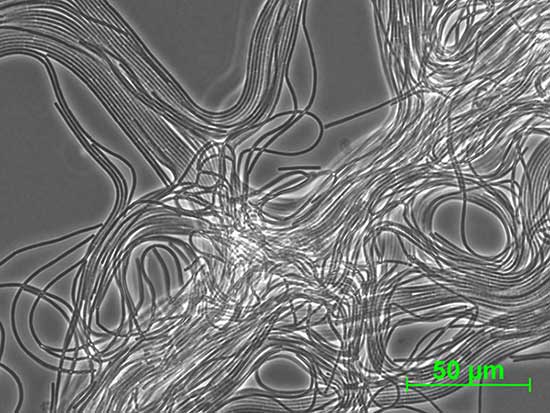
They are very long thin filament-shaped bacteria. Some of them form branching filaments resulting in a network of filaments called ‘mycelium’.
Example: Candidatus Savagella
2. Star Shaped Bacteria
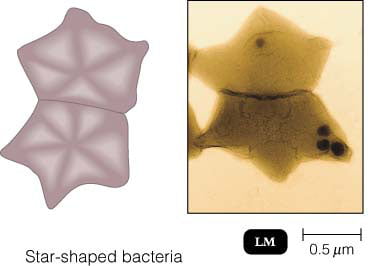
Example: Stella
3. Rectangular Bacteria
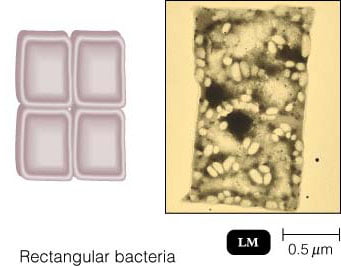
Examples: Haloarcula spp (H. vallismortis, H. marismortui)
4. Pleomorphic Bacteria
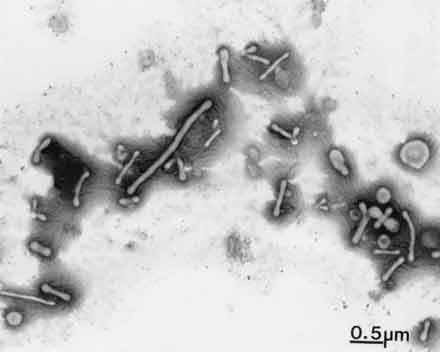
These bacteria do not have any characteristic shape unlike all others described above. They can change their shape. In pure cultures, they can be observed to have different shapes.
Examples: Mycoplasma pneumoniae, M. genitalium, etc.

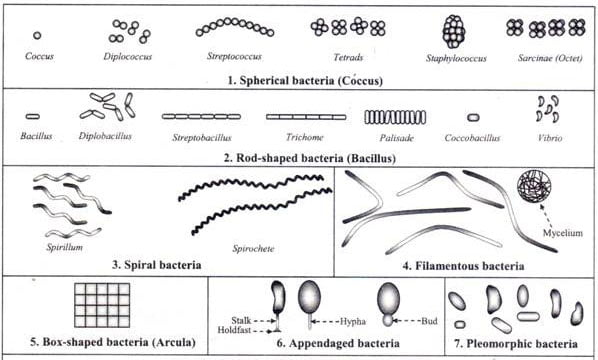




No comments:
Post a Comment
Due to the high number of spammy comments we have decided to initiate comment moderation so that we can maintain our quality standards and make good environment for our visitors. Please leave your comment